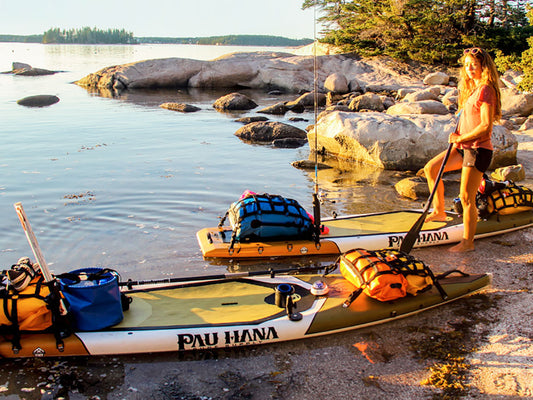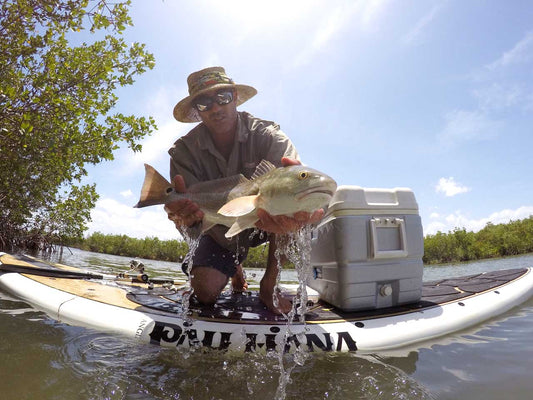If you’ve spent any time around paddleboarders, you may have noticed one thing: no two people paddle the same way. Some love slow laps on a quiet lake or river. Others chase sunrise workouts. Some float through yoga flows, and a few can’t resist paddling straight toward the nearest wave.
That’s the beauty of this diverse sport, and why not all boards are built alike.
Think of this guide as your waterside matchmaker. We’ll walk through the main types of SUPs, what makes each type special, and which paddling personalities they suit best, so you can find the board that feels like it was made just for you.
All-Around SUPs: The Do-Everything Crowd-Pleaser
The all-around SUP is the one board most people ends up reaching for. It’s stable, adaptable, and easygoing. It’s the kind of board that helps new paddlers find their balance and lets seasoned paddlers cruise without overthinking it.
What makes it tick:
- A friendly, rounded nose
- A wider platform for stability and easy balance
- Typically 10-12 feet long and 32-36 inches wide
- A soft, roomy deck pad that’s comfortable for standing, kneeling, or just full-on sunbathing
Great for:
- First-timers learning the basics and gaining balance
- Casual paddling on lakes, rivers, or calm ocean days
- Families who only want one board that works for everyone
- Light surf when you’re ready to start playing a little
If you’re staring at a lineup of boards wondering where to begin, an all-around board is usually your safest (and happiest) bet.
Touring SUPs: Built for the Long Haul
For the paddlers who see water and immediately think, “How far can I go?”, a touring SUP is the trusted travel companion. These boards are designed to glide efficiently over long distances and rack up the kilometres - the equivalent of lacing up running shoes instead of flip-flops.
Signature traits:
- A pointed, displacement nose that slices cleanly through the water
- Longer lengths (11-14 feet) with a narrower width (28-32 inches)
- Space for gear: like bungees, attachment points, and places to secure dry bags
Perfect for:
- Longer paddle missions and multi-day adventures
- Fitness paddlers wanting an endurance workout
- Exploring big lakes, coastlines, or open water routes
They’re particularly speedy and efficient but less stable than all-around boards, so they’re best for paddlers with some experience and good balance.
Racing SUPs: For the Speed-Obsessed
Slip one of these into the water and you’ll know instantly: racing boards mean business. They’re super narrow, fast, and unapologetically performance-focused. If you thrive on competition and challenge or crave maximum speed, this is category for you.
What defines a race board:
- Long, needle-like outline with a sharp, pointed nose
- Ultra-narrow width - usually 26-30 inches
- Lightweight, high-performance construction like carbon fibre
- Displacement hull that cuts through water with very minimal drag
Best suited to:
- Competitive racers and serious athletes
- Experienced paddlers with excellent balance
- Flatwater or lightly choppy conditions
These boards are not for beginners, but if you’re chasing personal records or preparing for an event, nothing quite compares.
Inflatable SUPs: Adventure-Ready and Easy to Live With
Inflatable SUPs - or iSUPs - have exploded in popularity, and for many good reasons. They pack down small, shrug off dings, and are ridiculously travel-friendly. Modern, high quality inflatables are so well engineered that many paddlers hardly feel a difference compared to rigid boards!
What sets them apart:
- Super durable construction using reinforced PVC or TPU
- Can be inflated to high PSI for impressive rigidity
- Roll up small enough to fit in backpacks or car boot
- Don’t require roof racks
Perfect for:
- Travellers and backcountry explorers
- Paddlers with limited storage space
- SUP yoga, recreational paddling, and casual surf
- Anyone who prefers grab-and-go convenience
Inflatables are the “take me anywhere” solution - ideal if life takes you through airports to lakes and remote beaches.
Yoga SUPs: Your Floating Studio
If your soul lights up at the idea of sun salutations on the water, a yoga-specific SUP is your go to sidekick. These boards focus on stability and surface area so you can move confidently between poses without wobbling like a newborn deer.
Standout features:
- Extra width (often 32-36 inches) for unmatched stability
- Full-length soft deck pad for grip and comfort through poses
- Flat, open platform that feels like a yoga mat on water
Made for:
- Yogis wanting a mindful session in nature with minimal distractions
- Beginners who crave stability above everything
- Calm water: bays, lakes, quiet mornings on the ocean
Yoga SUPs are a great way to slow down, breathe deeper, and feel completely grounded - even while floating.
Surf SUPs: For Paddlers Who Love the Break
Surf SUPs are your ticket to riding waves with power and style. Shorter, way less stable but way more manoeuvrable, these boards bring together the glide of a SUP with the playful energy of a surfboard.
How they’re built:
- Short length (8-10 feet) for quick, powerful turns
- More rocker in the nose for staying above the wave face
- Narrower outline for sharper response
- Thruster or quad fin setups for control in the pocket
Ideal for:
- Paddlers confident in the surf
- Intermediate to advanced riders ready to catch waves
- Ocean conditions with consistent surf
They’re not great for flat water, but when the waves are pumping? These boards are pure magic.
The Bottom Line: Choose the Board That Matches Your Water Lifestyle
Every paddler has their own rhythm - their own idea of that perfect session. Maybe you crave long coastal tours. Maybe you love a slow drift at sunset. Or maybe catching waves fires you up like nothing else does.
There’s a board built for that.
Understanding the differences between the different types of SUPs gives you the clarity to pick a board that feels right from the very first stroke. Choose based on where you paddle, how you paddle, and the moments you want more of - and you’ll find the board that turns every outing into your personalised after-work escape.





